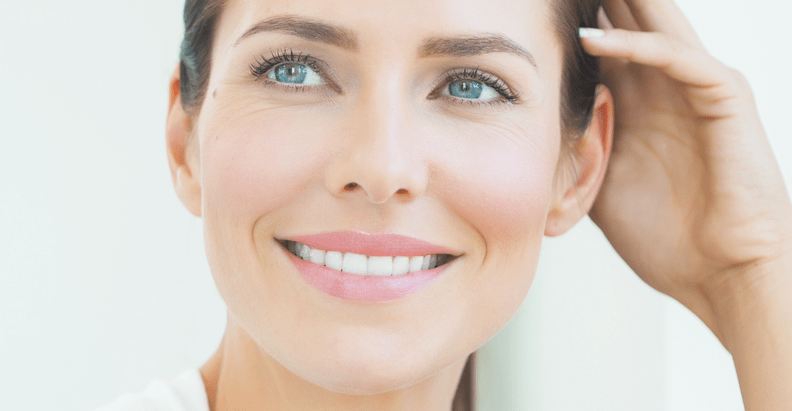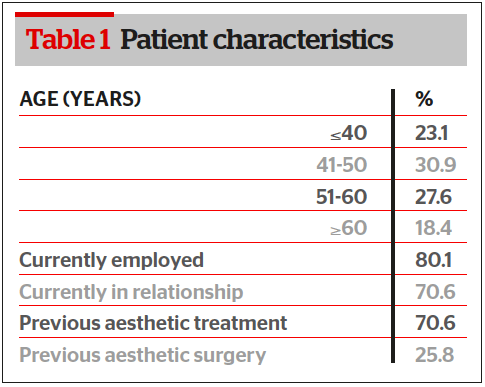Henry Delmar, Eva Guisantes, Pier Antonio Bacci, Pyra Haglund, Wojciech Marusza, Lyudmil Peev, and Valérie Philippon discuss findings from the European ART (Art Reflexion Therapy) survey on self-esteem after aesthetic corrective treatments with HA filler
AT PRESENT, THERE IS AN INCREASING variety of dermal fillers available for aesthetic rejuvenation purposes that correct facial wrinkles and folds, facial volume deficits, fine lines, and improve skin quality; such products are also used for facial contouring and the augmentation of lips and cheeks1. The use of dermal fillers is now challenging, and in many circumstances replacing, more invasive and traditional aesthetic surgical treatments2. Indeed, according to the International Society of Aesthetic Plastic Surgery, more than 11 million non-surgical aesthetic procedures were performed in the US in 2016, of which over 3 million involved the application of resorbable fillers3.
Many of the newer fillers are based on hyaluronic acid (HA) and its derivatives, and the Cosmetic Surgery National Data Bank Statistics of the American Society for Aesthetic Plastic Surgery reported that in 2016 there was a 16% increase in the use of HA fillers compared to the previous year with almost 2.5 million procedures performed4. Over 90% of such procedures were performed on women.
Correction of nasolabial folds has been suggested to have a positive impact on the subject’s overall well-being, quality of life and self-esteem with potential improvements even in social interactions5–9. Despite their increasingly widespread use, with millions of subjects treated, there have been surprisingly few studies carried out on patient and physician regarding the overall benefits of HA-based dermal fillers.
This is an important aspect, especially considering that the overall objective in the use of dermal fillers is to increase the patient’s attractiveness and self-confidence. Self-esteem is a complex psychological concept that refers to the overall positive or negative judgment of oneself and encompasses confidence in one’s judgments, opinions, convictions and strengths10,11.
Self-esteem takes into account how one is perceived by others, and thus has a strong impact on how one perceives the outside world. Poor self-esteem can be associated with unhappiness and difficulties in interpersonal relationships, both professional and private. For example, in an Australian survey of adults who had used aesthetic plastic surgery, a correlation was found between higher self-esteem, job satisfaction and a reduction in the number of burnout cases12. Thus, the perception of one’s own physical appearance has an impact on wellbeing and is an important parameter to evaluate when considering the outcomes of aesthetic procedures.
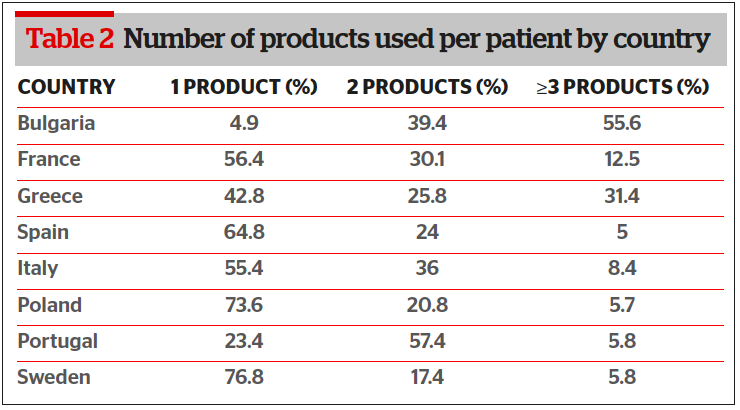
To address this lack of data, the European ART® (Art Reflexion Therapy) survey was performed, whose primary objective was to assess the impact of HA-based filler range, the ART FILLER® range, on self-image and self-esteem. The present study is the largest such survey carried out to date, and one of the few large surveys to assess treatment impact on self-esteem. Such data is important not only to give clinicians some insight about post-procedural success but also to give the patient a new way of considering aesthetic procedures beyond simple aesthetic outcomes.
Materials and Method Study design
The present multicentre survey was a prospective, real-life, descriptive study that involved a total of 176 investigators (29 in France, 20 in Sweden, 19 in Italy, 6 in Greece, 12 in Bulgaria, 37 in Poland, 46 in Spain, and 16 in Portugal). Investigators were contacted among those routinely using ART FILLER® products13 who freely agreed to participate in the study. The investigators were given a series of questionnaires to administer to consecutive patients undergoing dermal filler treatments for rejuvenation treatments with one or more ART FILLER® products. There were no strict patient selection criteria regarding age, sex and contraindications to take part in the study, which was thoroughly explained to all patients, along with a signed informed consent form. A total of 1036 questionnaires were received, of which 964 were completed in their entirety to allow data collection and insertion into a common database.
Study questionnaires and assessments This survey involved two questionnaires: one for patients, and one for physicians. The patient questionnaire was also divided into three parts to assess:
- The patients’ self-image in their private and professional lives, previous aesthetic treatments, their opinion of facial features and skin quality, wishes for modification/correction and a self-esteem ‘real age versus apparent age scale’
- Results after the injections, on the same day
- Changes noticed 1 month after the injections, with responses to the same questions as before the injections. Patient self-esteem was assessed using Rosenberg’s Self-esteem Scale, which is one of the most frequently-used questionnaires for measuring overall self-esteem14. The test has ten questions with four possible responses, scored from one to four, and all responses are summed to obtain the total score. Higher scores indicate higher self-esteem.
- The physician questionnaire was divided into three parts:
- Pre-injection to determine the patient’s treatment plan
- At the time of the dermal injections to indicate the product(s) used per zone and the volume injected in mL, to note the practitioners’ impression of ease of injection, the product’s ease of modelling (moldability) and injection comfort, and to assess tolerance
- At a 1 month follow-up visit to assess the overall aesthetic result (physician GAIS — Global Aesthetic Improvement Scale), note the patient’s impressions, assess tolerance and determine the treatment follow-up plan. Descriptive statistics were used to compare patient and physician assessments.
Study products
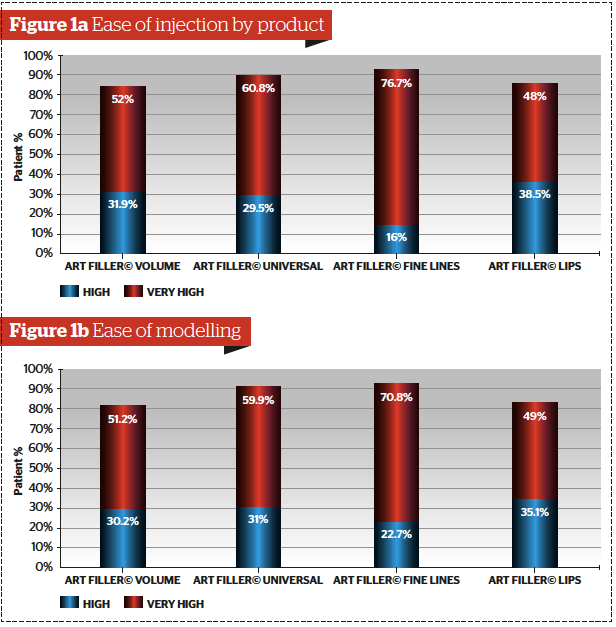
Results
Patient characteristics
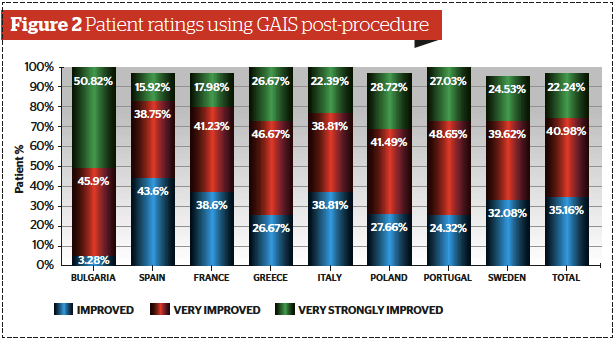
Quantities and types of products injected
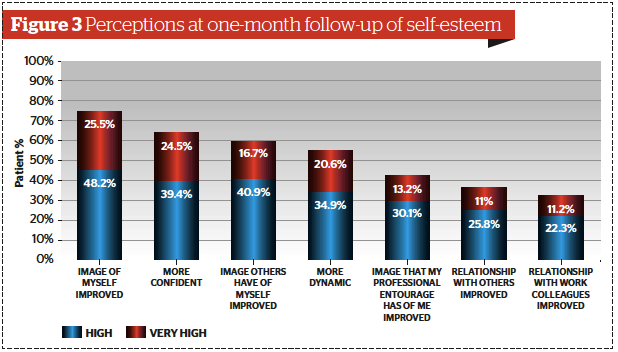
Physician-related endpoints
In general, the most common site of injection was the nasolabial folds, followed by the cheeks and lips. Other sites, such as the chin, forehead, jugal fold, temples, nose and other were injected much less (generally <5%). The average for the physician GAIS was 1.88, with the highest score in Bulgaria at 2.38 and the lowest in Sweden at 1.71. Ease of injection was considered high or very high in more than 80% of subjects for all products combined. Considering individual products, ART FILLER® Fine Lines had the highest rate of approval, with more than 90% of practitioners reporting high or very high ease of injection (Figure 1A). There was no substantial variation in physician-assessed ease of injection by country. Ease of modelling was rated high or very high in more than 80% of cases, with the highest scores (>90%) for ART FILLER® Fine Lines and ART FILLER® Universal (Figure 1B). There was no substantial variation in physician-assessed ease of remodelling by country. All products were assessed by physicians to be associated with good injection comfort.
Very high or high rates of injection comfort were reported for ART FILLER® Volume, ART FILLER® Universal, ART FILLER® Fine Lines, and ART FILLER® Lips in 86.8%, 90.8%, 94.6% and 76.3% of physicians. The comfort of injection was high or very high in 52.6% of the cases for ART FILLER® Lips and 69.3% of cases for ART FILLER® Fine Lines in Sweden, while it was high or very high in 77.8% of the cases for ART FILLER® Lips in Portugal. In all the other cases, for all products and countries, injection comfort was rated as high or very high in more than 80% of cases. There were no other substantial differences in ratings of injection comfort between countries.
Patient-related endpoints
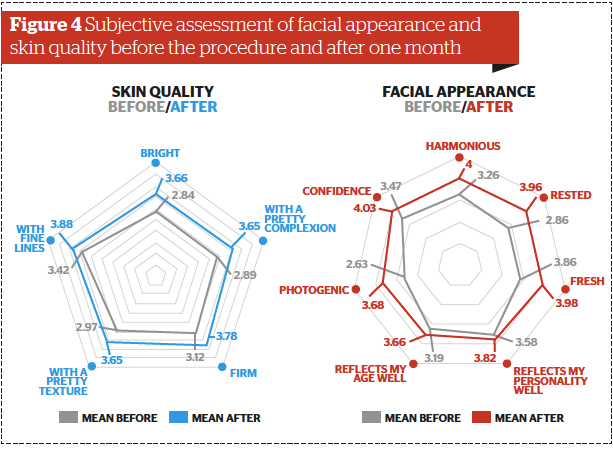
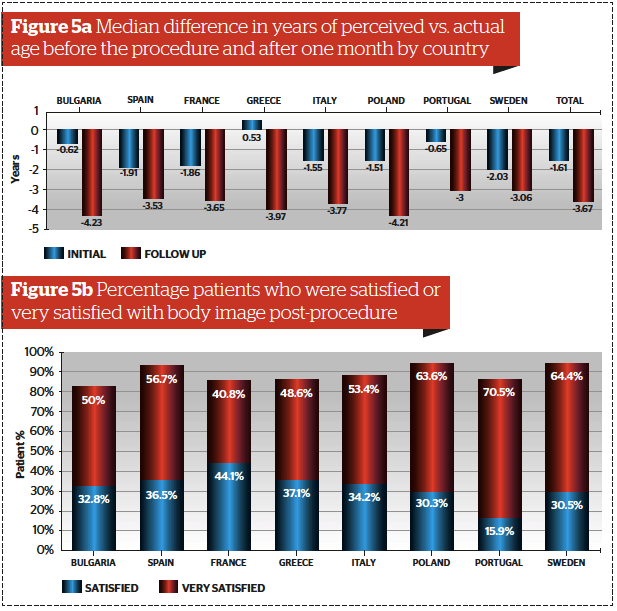
Tolerability
Immediately following the injection session, adverse events were observed in 95 of the 964 patients (9.9%; Table 3). A total of 125 events were reported in 95 patients, the most frequent of which was oedema (4.0%; 39 events), followed by haematoma (2.8%; 27 events) and erythema (2.2%; 21 events). At one month after the injection, 81 adverse events were reported (8.4%); consistent with the adverse events at the initial session, the most frequent were oedema (2.8%) and haematoma (1.4%). The majority of adverse events that were rated were considered to be of mild intensity (38 of 66; 57.8%), and the majority were also transient (41 of 61; 67.2%). The vast majority of adverse events were considered by the investigators to be possibly, probably or definitely injection-related (55 of 57; 96.5%). 86.4% of AE occurred in three countries: Spain (n=41), Italy (n=20) and Sweden (n=9). Greece and Portugal reported only one case of oedema each.
Discussion
To our knowledge, the present survey is the largest to date evaluating patient-rated perceptions of aesthetic changes following treatment with dermal fillers. Such changes are important since they can have a profound influence on the patient’s overall self-perceived attractiveness and well-being as well as self-esteem and social interactions. This pan-European survey involved eight countries, and demonstrated positive correlations, albeit to different degrees, in all endpoints assessed and in all settings. Firstly, improvements in the GAIS in virtually all women were referred. While some differences in the degree of improvement could be noted between countries, such differences might in part be attributed to differences in subjective ratings. For example, a similar degree of improvement might be rated as very strongly improved by a woman in one country, and as only strongly improved by a woman in another. Nonetheless, such results are not unexpected, and previous studies have also documented improvements in the GAIS using other types of HA-based dermal fillers15–18.
Adverse events were seen in less than 10% of women, the majority of which were transient and self-resolving. Moreover, the majority of adverse events were related to the injection itself, i.e. oedema, hematoma, and erythema. In this regard, some differences were noted between countries in the frequency of adverse events, which might suggest that investigator experience plays a role in the appearance of such adverse events. However, the present study was carried out under ‘real-life’ conditions, and assessment of adverse events with individual investigators was beyond the scope of the present survey.
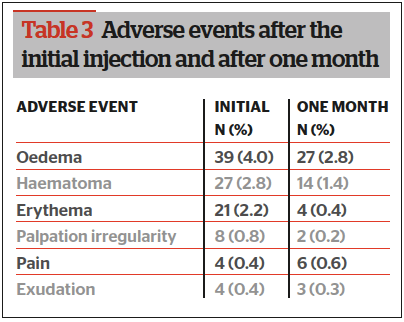
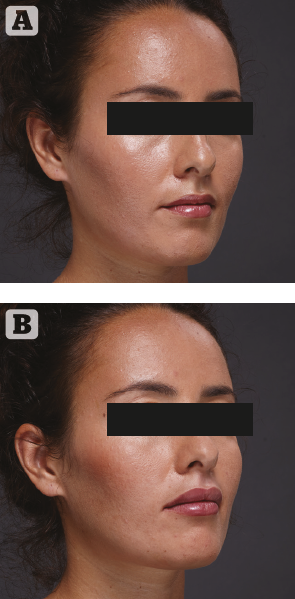
Figure 6 (A) Before and (B) After ART FILLER® dermal filler treatment
In addition, subjective improvements in facial appearance and skin quality were reported by the majority of women, which was reflected in a higher perception of a fresh appearance and being more photogenic. In fact, on average, women reported that they looked >2 years younger than their actual age after the treatment. A multicenter study in 235 patients with a volumizing HA filler also reported that the majority of women were satisfied with facial appearance in the long-term (89.8% at 6 months; 75.8% at 2 years), and reported looking an average of 3 years younger at 2 years, further confirming the patient-reported benefits of HA fillers in the long-term17.
Lastly, it is important to point out that virtually all women, across all countries, referred that they would undergo the treatment again. This is a significant finding since over 70% of women had already undergone aesthetic treatments, and about 25% had had some form of surgical intervention. The relevance of this lies in the fact that dermal filler treatments with HA are non-invasive compared to surgical treatments, and are well-tolerated. Past studies in smaller patient groups have also reported that women undergoing such treatments had a high likelihood of returning for additional treatment as well as their willingness to recommend treatment to others15,18-20.
Concerning physician-related endpoints, it is worth highlighting that the ART range of products was rated highly in terms of ease of injections and modelling, with no significant variation in responses by country. The products were also considered to be associated with a high degree of injection comfort. While encouraging, it should, however, be kept in mind
that there were no technical limitations in injection technique for the study, and investigators were free to choose whatever technique they preferred. In addition, different injection techniques are used for various areas of the face and with different products, but the entire product range was still evaluated favourably.
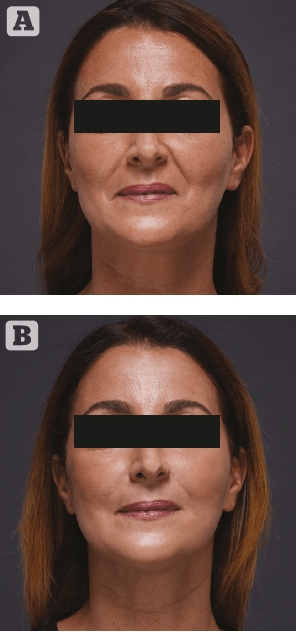
Figure 7 (A) Before and (B) After ART FILLER® dermal filler treatment
There are several limitations to the present study. While prospective, the patient-reported outcomes were not fully validated and only subjective impressions were considered. In addition, being pan-European, there were no study protocols for use of a standardised injection technique or strategy. All correction plans and treatment protocols were individualised by the investigator and the subject undergoing cosmetic treatment, even if it is clear that different treatment plans were used when comparing different countries. For example, multiple products were used in more women in Bulgaria than in Sweden, but such differences may also reflect geographic differences in the desired cosmetic effects to be achieved. At any rate, however, such situations are reflective of real-life settings. In addition, only the ART FILLER® range of products was used, although the study was not conceived to be comparative but rather had the primary goal of assessing patient-reported outcomes after treatment to investigate how these affect the patient’s self-esteem and opinions about the overall outcome of the procedure. Lastly, the time of follow-up evaluation was limited to one month.
The present study is one of the few and largest to date to assess the impact of dermal filler treatment on self-esteem, and there still remains an objective need for additional information on how women perceive the cosmetic changes after treatment with HA-based fillers. It is clear from the present data and previous studies that positive correlations are seen between HA injections and objective aesthetic improvement. Moreover, dermal fillers appear to have a genuine impact on self-perceived attractiveness, self-esteem and quality of life, even if the latter was not assessed with a specific questionnaire. These treatments also appear to have a positive influence on social and professional interactions. The ART FILLER® line of products was associated with high favorability by physicians in terms of ease of use and modelling. The entire product range was well tolerated, and the majority of adverse events were mild in nature, transient and self-resolving. Our results reinforce the benefits that the ART FILLER® line of HA-based dermal fillers has on patient-evaluated outcomes and physician-assessed endpoints. These benefits are, indeed, reflected in the fact that virtually all patients would undergo the procedure again and would recommend it to others. The results also confirm for the first time in a pan-European real-world setting the positive impact that dermal fillers can have on self-esteem and well-being measured dedicated survey-based questionnaires.
Declaration of interest The authors acknowledge FILLMED by FILORGA for providing the fillers used in the present study.
Figures 1–5 © Dr Delmar Tables 1-4 © Dr Delmar
- Dong J, Gantz M, Goldenberg G. Efficacy and safety of new dermal fillers. Cutis. 2016;98(5):309-313.
- Palm MD. Filler frontier: what’s new and heading West to the US market. Semin Cutan Med Surg. 2014;33(4):157-163.
- Surgery ISoAP. International survey on aesthetic/cosmetic procedures performed in 2013. Available from: http://www.isaps.org/Media/Default/global-statistics/2014 ISAPS Results %283%29.pdf. Accessed 27 Aug 2017.
- Surgery ASfAP. Cosmetic Surgery National Data Bank Statistics. Available at: https://www.surgery.org/sites/default/files/ASAPS-Stats2016.pdf. Accessed 27 Aug 2017.
- Dayan SH, Arkins JP, Gal TJ. Blinded evaluation of the effects of hyaluronic acid filler injections on first impressions. Dermatol Surg. 2010;36 Suppl 3:1866-1873.
- de Aquino MS, Haddad A, Ferreira LM. Assessment of quality of life in patients who underwent minimally invasive cosmetic procedures. Aesthetic Plast Surg. 2013;37(3):497-503.
- de Arruda LH, Rocha FT, Rocha A. Studying the satisfaction of patients on the outcome of an aesthetic dermatological filler treatment. J Cosmet Dermatol. 2008;7(4):246-250.
- Pallua N, Wolter TP. A 5-year assessment of safety and aesthetic results after facial soft-tissue augmentation with polyacrylamide hydrogel (Aquamid): a prospective multicenter study of 251 patients. Plast Reconstr Surg. 2010;125(6):1797-1804.
- Tzikas TL. A 52-month summary of results using calcium hydroxylapatite for facial soft tissue augmentation. Dermatol Surg. 2008;34 Suppl 1:S9-15.
- Pronin E. Perception and misperception of bias in human judgment. Trends Cogn Sci. 2007;11(1):37-43.
- Pronin E. How we see ourselves and how we see others. Science. 2008;320(5880):1177-1180.
- Kalas AR, Cregan C. Cosmetic facial surgery: the influence of self-esteem on job satisfaction and burnout. Asia Pacific J Human Resources. 2017;55(3):DOI: 10.1111/1744-7941.12137.
- Trevidic P, Andre P, Benadiba L, et al. Prospective, Split-Face, Randomized, Long-Term Blinded Objective Comparison of the Performance and Tolerability of Two New Hyaluronic Acid Fillers. Dermatologic Surgery 2017. 43(12): 1448–1457

